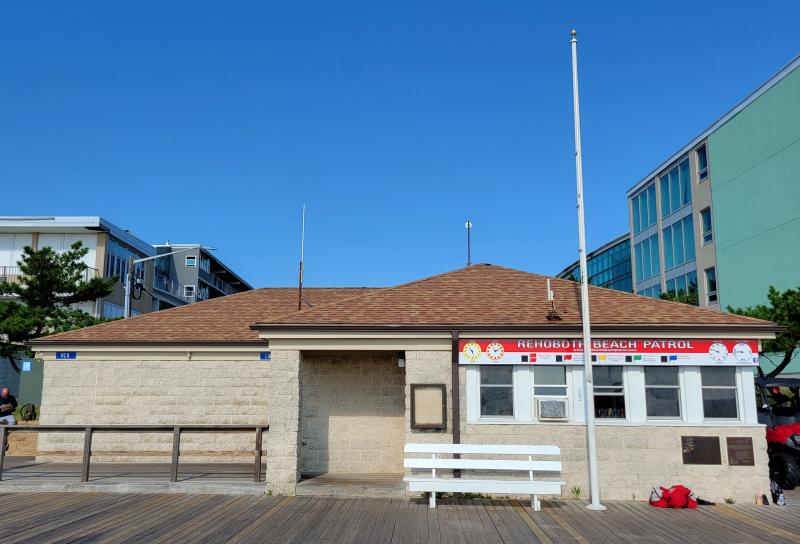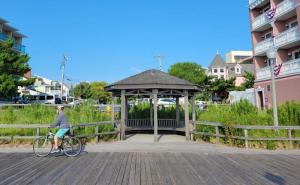Should Rehoboth move its beach patrol building?
For months now, Rehoboth Beach officials, citizens and business owners serving on a task force have been discussing ways to improve the streetscapes along Wilmington and Baltimore avenues.
Primarily, proposed improvements have focused on pedestrian safety and ease of movement throughout the designated area. However, one of the tasks given to the group was to make the Boardwalk ends of Wilmington and Baltimore avenues more enticing in order to pull people off the Boardwalk, down those streets, and ultimately, into businesses.
During a July 28 meeting, Rossi Group, a consultant hired by the Delaware Department of Transportation to help the city through this streetscape design process, presented a conceptual design for the east end of Wilmington Avenue that included a shaded, tree-lined pavilion, and a new turnaround for passenger drop-off. The design for the end of Baltimore Avenue included new trees and a small pavilion, but it was much less inviting, partly because the beach patrol building is there, said Alexis Morris, a senior planner for Rossi Group.
Interestingly, at the same time the task force is doing its thing, the city is working on redesigning the beach patrol building – from the current one-story structure with beach patrol on one side and public restrooms on the other, to a two-story building with improved restroom facilities on the first floor and the beach patrol on the second floor.
With that in mind, task force member Frank Cooper suggested July 28 that now may be a good time to think about moving the RBP building one block north to Maryland Avenue. It’s a big building that’s obstructing and uninviting, he said during the meeting.
During the task force’s most recent meeting, Aug. 4, Jenny Burton, a Baltimore Avenue business owner, said the beach patrol building is definitely in the way, and the proposed concept is not as inviting as the one for Wilmington.
Cooper said Aug. 4 that another design could have a one-story building at Baltimore and one at Maryland.
Following the meeting, Lynne Coan, city spokesperson, said city staff – Police Chief Keith Banks, who is in his second year of overseeing the beach patrol, and first-year RBP Capt. Jeff Giles – haven't had sufficient time to consider the pros and cons of the relocation idea.
“The mayor and board of commissioners may discuss the proposed idea of moving the beach patrol to Maryland Avenue, but the idea is in early stages and there’s much conversation needed. If the board of commissioners discuss the idea in the future, we anticipate that they will seek information and insights from beach patrol staff,” said Coan in an Aug. 5 email.
Removal of parking spaces
The main topic of discussion for the task force continues to be the proposed removal of parking spaces to make room for the pedestrian safety upgrades and other improvements.
Last week, Rossi Group showed a conceptual redesign of the area in question that included a 25 percent reduction in parking spaces – 331 to 246.
During the recent meeting, Mills said he wasn’t in favor of removing any parking spaces, but the purpose of the task force is to increase pedestrian safety and ease of travel, and with that there will be a sacrifice in parking and other areas.
As proposed, First Street would see the largest number of parking spots removed - 44 down to 14, including all the spaces on the first block of North First Street.
Task force member Patty Hoffman, owner of Stitch-Stash on the second block of North First Street, said she didn’t want to see any of the parking on First Street removed. She said most of her customers are older than 60, and they won’t come to her store if they can’t park nearby.
Task force member and city Commissioner Edward Chrzanowski said he didn’t like seeing all the parking on the west side of the first block of South First Street removed. He suggested a few parking spots could be relocated to the east side of South First Street, where there are no doors opening to the street because it’s the wall of First Street Station.
Rossi’s concept did include the addition of two parking spaces on South Second Street, between Wilmington and Delaware avenues.
Task force member Bob Pomeranz recommended not adding those parking spots. He said he travels that section of Second Street almost daily, and it can get busy because of the cars turning off Christian Street and Delaware Avenue onto Second Street. Henlopen City Oyster House owner and task force member Joe Baker agreed with Pomeranz’s evaluation of the intersection.
Other task force discussion points
The task force agreed that the pedestrian access route, an unobstructed path on what is generally thought of as the sidewalk, should be seven feet wide whenever possible. Rossi’s concept had a five-foot-wide access route, but the group agreed that trying to maintain the widest path possible was best.
The task force also continued to talk about how to best address the tapering of Baltimore and Wilmington streets. Currently, vehicular travel lanes widen as they get closer to the Boardwalk. As proposed, the vehicular travel lanes would stay the same width, and sidewalks would get wider.
Business owners on the task force all said the tapered vehicular travel lanes allow multiple trucks to deliver supplies to businesses on those streets, and also to businesses on the Boardwalk, so narrowing the travel lanes would make the congestion worse.
The task force is not scheduled to meet again until it can approve the minutes for the recent meeting. After the minutes are approved, the task force’s comments on Rossi’s design will be presented to him, and an updated plan will be created before a public meeting is conducted in September. A date for that meeting has not yet been set, but the timetable presented by Rossi anticipates the task force completing its work by November.














































